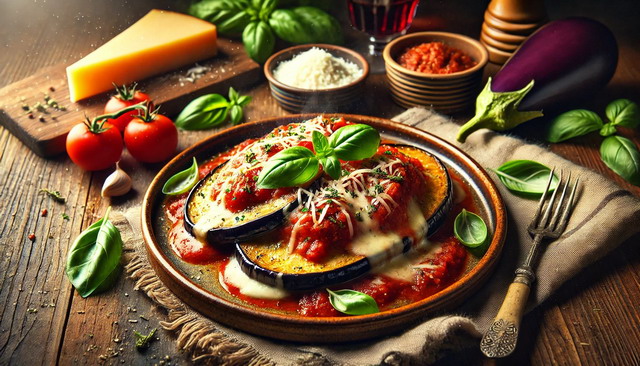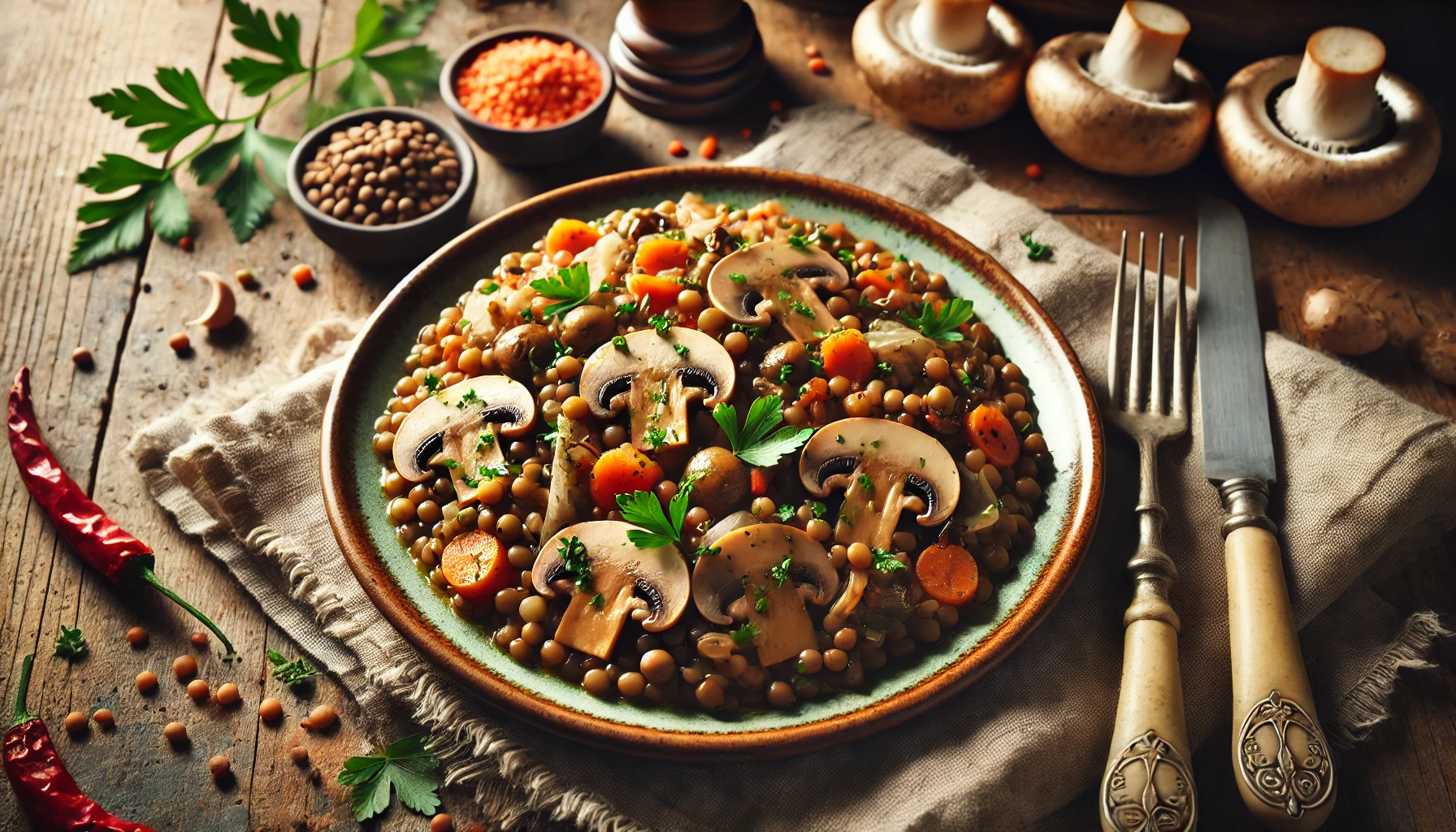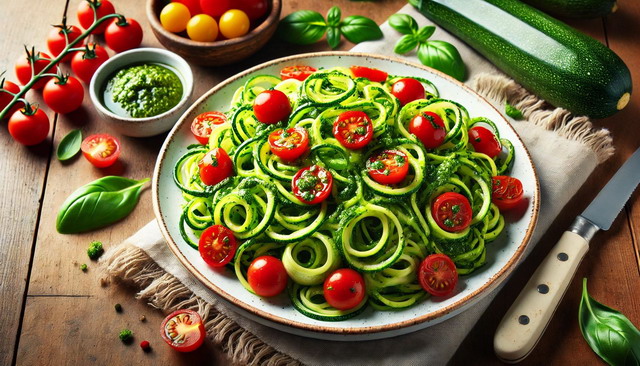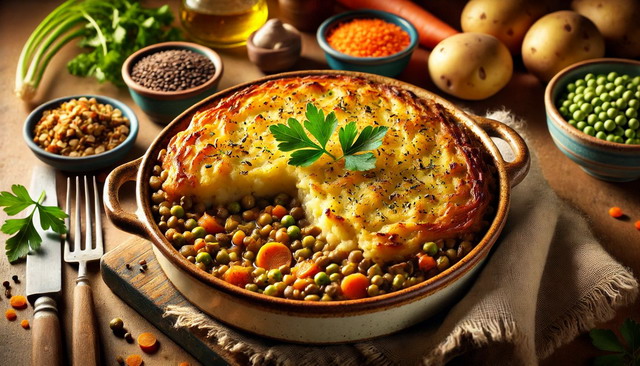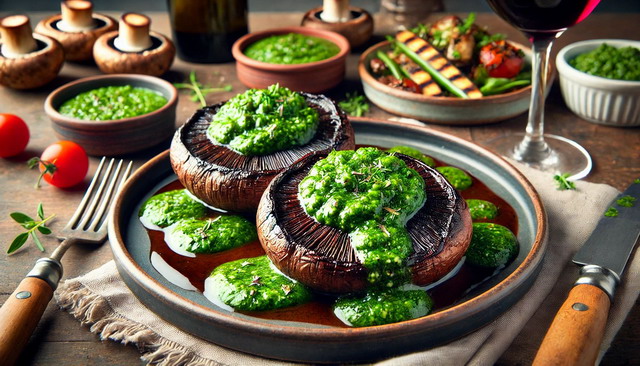Eggplant Parmesan, or “Melanzane alla Parmigiana” as it’s known in Italy, is a classic Italian dish that has won hearts around the world with its layers of tender eggplant, rich tomato sauce, and gooey melted cheese. But when you add the fresh, aromatic touch of basil, the dish is elevated to new heights. The combination of eggplant and fresh basil is a match made in culinary heaven, bringing together earthy and herbal flavors that make this dish both comforting and sophisticated.
In this blog post, we’re diving deep into the world of Eggplant Parmesan with Fresh Basil, exploring what makes this dish so special, and offering tips on how to choose the best ingredients to create an unforgettable meal. Whether you’re a seasoned cook or a beginner in the kitchen, this guide will provide you with everything you need to know to make a dish that’s sure to impress.
What is Eggplant Parmesan with Fresh Basil?
Eggplant Parmesan is a staple in Italian-American cuisine, known for its layers of breaded and fried eggplant slices, tomato sauce, mozzarella, and Parmesan cheese, all baked to perfection. The dish is hearty, satisfying, and packed with flavor. But when fresh basil is added to the mix, it brings a bright, fragrant note that cuts through the richness of the cheese and the savory tomato sauce.
Basil, often referred to as the “king of herbs,” has been a central ingredient in Italian cooking for centuries. Its sweet, slightly peppery flavor pairs beautifully with the mild, slightly bitter taste of eggplant. When fresh basil is used in Eggplant Parmesan, it not only enhances the dish’s flavor but also adds a pop of color and freshness that makes the dish even more appealing.
Adding fresh basil to Eggplant Parmesan isn’t just about taste; it’s about respecting and honoring the ingredients. In traditional Italian cooking, the quality and freshness of ingredients are paramount. Basil, when fresh, offers a burst of flavor that dried herbs simply can’t match. This is why using fresh basil is crucial in creating a truly authentic and flavorful Eggplant Parmesan.
Choosing the Best Eggplant for Parmesan
Now that we’ve established the importance of fresh basil in this dish, let’s talk about the star of the show: the eggplant. Choosing the right eggplant is key to making a successful Eggplant Parmesan, as the texture and flavor of the eggplant can make or break the dish.
Best Type of Eggplant for Eggplant Parmesan
When it comes to Eggplant Parmesan, not all eggplants are created equal. The most commonly used eggplant in this dish is the globe eggplant, also known as the American eggplant. This variety is large, with a smooth, dark purple skin and a slightly spongy texture. Its size makes it perfect for slicing into rounds that can be layered in the dish.
However, other varieties can also be used depending on your preference. Italian eggplants, which are smaller and more elongated, have a slightly sweeter flavor and tender flesh, making them an excellent choice for a more delicate version of the dish. Japanese eggplants, which are even smaller and more slender, have a milder flavor and thinner skin, which means they don’t need to be peeled before cooking.
How to Choose the Perfect Eggplant
Selecting the right eggplant at the market is the first step to ensuring a delicious Eggplant Parmesan. Here are some tips to help you choose the best one:
- Look for Firmness: A good eggplant should feel firm to the touch, with no soft spots. If the eggplant is too soft, it may be overripe and could have a bitter taste.
- Check the Skin: The skin should be smooth and shiny, with a deep, rich color. Avoid eggplants with wrinkled or dull skin, as this is a sign of age and may indicate that the eggplant is past its prime.
- Weight Matters: A good eggplant should feel heavy for its size. This indicates that it is fresh and full of moisture, which is important for achieving the right texture in your dish.
- Size and Shape: While large eggplants are often preferred for Eggplant Parmesan because they yield more slices, don’t overlook the smaller varieties. Just be sure to choose eggplants that are uniform in size, as this will help them cook evenly.
- Storing Your Eggplant: Once you’ve selected your eggplant, it’s best to use it as soon as possible. However, if you need to store it, keep it in a cool, dry place, and avoid refrigeration, which can cause the eggplant to become bitter.
Preparing the Eggplant
Before cooking, it’s essential to prepare the eggplant properly. Start by slicing the eggplant into rounds about 1/4 inch thick. To remove any potential bitterness, sprinkle the slices with salt and let them sit for about 30 minutes. This process, known as “sweating,” draws out excess moisture and bitterness. Afterward, rinse the slices under cold water and pat them dry with paper towels.
With your eggplant prepared and fresh basil at the ready, you’re well on your way to creating a mouthwatering Eggplant Parmesan that’s sure to be a hit at any table. In the next sections, we’ll delve into the recipe itself, offering step-by-step instructions and tips to ensure your dish is a success.
The Role of Fresh Basil in Enhancing Flavor
Fresh basil is much more than just a garnish; it’s a fundamental ingredient that can transform a dish from good to exceptional. In Eggplant Parmesan, the inclusion of fresh basil adds a vibrant, aromatic quality that balances the richness of the cheese and the acidity of the tomato sauce. But why exactly is fresh basil so essential, and how does it enhance the overall flavor profile of this beloved dish?
Why Use Fresh Basil in Eggplant Parmesan?
Basil has been a cornerstone of Italian cuisine for centuries, revered for its distinctive flavor that is simultaneously sweet, savory, and slightly peppery. When fresh basil is used in Eggplant Parmesan, it infuses the dish with a fresh, green note that cuts through the heavier elements like cheese and fried eggplant. This not only brightens the dish but also adds a layer of complexity that dried basil or other herbs simply cannot replicate.
The freshness of basil also plays a critical role in the overall eating experience. When fresh basil is added to a hot dish, its delicate leaves release a burst of essential oils that immediately elevate the aroma, making the dish more inviting. This sensory experience starts before you even take your first bite, setting the stage for a meal that is as delightful to the nose as it is to the palate.
Pairing Basil with Eggplant
Eggplant, with its mildly bitter and earthy flavor, is the perfect partner for basil. The herb’s bright, clean taste contrasts beautifully with the eggplant, helping to enhance its natural flavors without overpowering them. This balance is crucial in Eggplant Parmesan, where the goal is to create a harmonious blend of flavors rather than allowing any one ingredient to dominate.
Additionally, basil complements the other ingredients in Eggplant Parmesan—especially the tomato sauce. Basil and tomatoes are a classic combination in Italian cooking, with basil enhancing the sweetness of the tomatoes while also adding a slight peppery bite that rounds out the sauce. When layered with eggplant and cheese, this trio creates a symphony of flavors that is both comforting and sophisticated.
Tips for Using Fresh Basil
To get the most out of fresh basil, it’s important to use it correctly. Here are a few tips:
- Add Basil at the Right Time: Basil’s delicate leaves can quickly lose their flavor and color when exposed to high heat for too long. To preserve its freshness and vibrancy, add basil towards the end of cooking or sprinkle it on top of the dish just before serving.
- Tear, Don’t Cut: When preparing fresh basil, it’s best to tear the leaves by hand rather than chopping them with a knife. This helps to preserve the essential oils in the leaves, ensuring that the basil retains its full flavor.
- Store Basil Properly: If you’re not using your basil immediately, store it in a glass of water on the countertop, like a bouquet of flowers. This will keep it fresh for longer than storing it in the refrigerator, where the leaves can quickly wilt and turn brown.
Step-by-Step Recipe: Eggplant Parmesan with Fresh Basil
Now that we’ve explored the importance of fresh basil and how to choose the best eggplant, it’s time to bring these ingredients together in a step-by-step recipe for Eggplant Parmesan with Fresh Basil. This recipe is designed to be both delicious and approachable, so even if you’re new to cooking, you’ll be able to create a dish that rivals those from your favorite Italian restaurant.
Ingredients:
- 2 large eggplants, sliced into 1/4-inch rounds
- Salt, for sweating the eggplant
- 1 cup all-purpose flour
- 3 large eggs, beaten
- 2 cups breadcrumbs (preferably panko for extra crunch)
- 1/2 cup grated Parmesan cheese
- 2 cups shredded mozzarella cheese
- 3 cups marinara sauce (homemade or store-bought)
- 1 bunch fresh basil leaves, torn
- Olive oil, for frying
- Freshly ground black pepper, to taste
Instructions:
- Prepare the Eggplant:
- Start by salting the eggplant slices to draw out moisture and reduce bitterness. Lay the slices on a baking sheet lined with paper towels, sprinkle them generously with salt, and let them sit for 30 minutes. Afterward, rinse the slices under cold water and pat them dry.
- Bread the Eggplant:
- Set up a breading station with three shallow dishes: one with flour, one with beaten eggs, and one with breadcrumbs mixed with grated Parmesan. Dredge each eggplant slice in flour, then dip it in the egg, and finally coat it with the breadcrumb mixture. Press the breadcrumbs onto the eggplant to ensure an even coating.
- Fry the Eggplant:
- Heat a generous amount of olive oil in a large skillet over medium heat. Fry the breaded eggplant slices in batches until they are golden brown and crispy on both sides, about 2-3 minutes per side. Transfer the fried eggplant to a plate lined with paper towels to drain excess oil.
- Assemble the Dish:
- Preheat your oven to 375°F (190°C). Spread a thin layer of marinara sauce on the bottom of a baking dish. Arrange a layer of fried eggplant slices over the sauce, then top with more marinara sauce, a sprinkle of mozzarella, and a few torn basil leaves. Repeat the layering process, finishing with a layer of sauce and a generous topping of mozzarella and Parmesan.
- Bake the Parmesan:
- Cover the dish with foil and bake for 25 minutes. Then, remove the foil and continue baking for another 15-20 minutes, or until the cheese is bubbly and golden brown. Let the dish rest for a few minutes before serving to allow the flavors to meld together.
Serving Suggestions:
- Garnish with extra fresh basil leaves before serving. Eggplant Parmesan pairs beautifully with a simple green salad, garlic bread, and a glass of red wine like Chianti or Sangiovese.
Health Benefits of Eggplant and Basil
While Eggplant Parmesan is often seen as an indulgent dish, it also has several health benefits thanks to its key ingredients: eggplant and basil.
Health Benefits of Eggplant
Eggplant is a nutrient-dense vegetable that is low in calories but high in vitamins, minerals, and fiber. It’s particularly rich in antioxidants, such as nasunin, a type of anthocyanin found in the skin of purple eggplants. Nasunin has been shown to protect cells from damage caused by free radicals, potentially reducing the risk of certain chronic diseases.
Eggplant is also a good source of dietary fiber, which supports digestive health and helps to regulate blood sugar levels. Additionally, it contains small amounts of important nutrients like vitamin C, vitamin K, vitamin B6, and potassium, all of which contribute to overall health and well-being.
Health Benefits of Fresh Basil
Basil is another powerhouse ingredient with a range of health benefits. It’s rich in antioxidants, including eugenol, which has anti-inflammatory properties that may help reduce the risk of conditions like arthritis and heart disease. Basil also contains essential oils that have been shown to have antibacterial and antiviral effects, helping to support a healthy immune system.
Moreover, basil is a good source of vitamin K, which is important for bone health and blood clotting, as well as vitamin A, which supports eye health and immune function. The combination of these nutrients makes basil not only a flavorful addition to dishes but also a beneficial one for your health.
Balancing Flavor and Nutrition
By combining these two ingredients in Eggplant Parmesan, you’re not only creating a delicious meal but also one that offers a variety of health benefits. The key is to enjoy this dish in moderation and to balance it with other healthy foods, such as a side of vegetables or a light salad. This way, you can indulge in the rich, comforting flavors of Eggplant Parmesan while also nourishing your body with essential nutrients.
Tips for Perfectly Crispy Eggplant
One of the defining features of a great Eggplant Parmesan is the crispy, golden-brown eggplant that holds up to the layers of sauce and cheese without becoming soggy. Achieving this perfect crispiness can be a bit of a challenge, but with the right techniques, you can ensure that your eggplant has a satisfying crunch that enhances the overall texture of the dish.
How to Make Crispy Eggplant Parmesan
The first step to crispy eggplant begins with proper preparation. Here’s how you can ensure your eggplant turns out perfectly crisp every time:
- Sweat the Eggplant:
- As mentioned earlier, salting the eggplant slices and letting them sit for about 30 minutes helps to draw out excess moisture and bitterness. This step is crucial for achieving crispiness because moisture is the enemy of a good crust. After sweating the eggplant, be sure to rinse off the salt and pat the slices thoroughly dry with paper towels.
- Use Panko Breadcrumbs:
- For extra crunch, opt for panko breadcrumbs instead of regular breadcrumbs. Panko breadcrumbs are lighter and larger, which results in a crispier coating when fried or baked. You can also add a bit of grated Parmesan to the breadcrumb mixture for added flavor and crispiness.
- Double-Dip for Extra Crispiness:
- For those who love an extra-crispy coating, consider double-dipping the eggplant slices. After the first round of dredging in flour, egg, and breadcrumbs, repeat the process by dipping the slice back into the egg and breadcrumbs. This double coating will create a thicker, crunchier crust that holds up well during baking.
- Fry the Eggplant in Hot Oil:
- When frying the eggplant slices, make sure the oil is hot enough (around 350°F or 175°C) before adding the eggplant. Frying in hot oil ensures that the coating crisps up quickly, preventing the eggplant from absorbing too much oil and becoming greasy. Fry the slices in small batches to avoid overcrowding the pan, which can lower the oil temperature and result in soggy eggplant.
- Bake the Eggplant on a Wire Rack:
- After frying, bake the eggplant slices on a wire rack set over a baking sheet. This allows air to circulate around the slices, helping to maintain their crispiness as they cook in the oven. Avoid placing the slices directly on a baking sheet, as this can trap steam and make the bottom side of the eggplant soggy.
- Serve Immediately:
- To enjoy the eggplant at its crispiest, serve the dish as soon as it comes out of the oven. While the dish can still be delicious after sitting for a while, the longer it sits, the softer the eggplant will become as it absorbs the moisture from the sauce and cheese.
Pairing Eggplant Parmesan with Sides and Wine
Eggplant Parmesan is a rich and flavorful dish that can be complemented with a variety of sides and beverages. Pairing it with the right accompaniments can elevate your meal from ordinary to extraordinary, creating a dining experience that’s balanced and satisfying.
Best Sides with Eggplant Parmesan
Given the hearty nature of Eggplant Parmesan, it’s best to pair it with sides that offer contrast in texture and flavor, helping to balance out the richness of the dish.
- Simple Green Salad:
- A crisp, fresh salad is the perfect counterpoint to the warm, cheesy eggplant. Consider a salad with mixed greens, cherry tomatoes, cucumber, and a light vinaigrette dressing. The acidity of the vinaigrette cuts through the richness of the Parmesan, while the crisp vegetables provide a refreshing crunch.
- Garlic Bread:
- Garlic bread is a classic side that pairs beautifully with Eggplant Parmesan. The crusty bread and buttery garlic flavors complement the tomato sauce and cheese, and it’s great for sopping up any extra sauce left on your plate.
- Roasted Vegetables:
- For a more substantial side, consider serving roasted vegetables such as zucchini, bell peppers, or asparagus. The roasting process brings out the natural sweetness of the vegetables, which pairs nicely with the savory eggplant and tomato sauce.
- Pasta:
- If you’re looking for a more filling meal, a side of pasta, particularly spaghetti or penne with a light marinara sauce, is a great option. The pasta soaks up the flavors of the sauce and pairs well with the eggplant, creating a more substantial meal.
Wine Pairings with Eggplant Parmesan
Wine can be a wonderful accompaniment to Eggplant Parmesan, enhancing the flavors of the dish and adding to the overall dining experience. Here are some wine pairings to consider:
- Chianti:
- A classic Italian red wine, Chianti is known for its medium body, high acidity, and notes of red fruits and spices. The acidity in Chianti complements the tomato sauce, while its earthy undertones pair well with the eggplant.
- Sangiovese:
- Another excellent choice is Sangiovese, the grape variety used in Chianti. Sangiovese wines often have flavors of cherry, plum, and herbs, which match nicely with the basil and tomato in the dish. Its tannins help to cut through the richness of the cheese.
- Pinot Grigio:
- If you prefer white wine, Pinot Grigio is a versatile option. Its crisp acidity and light body make it a refreshing counterpoint to the heavier elements of Eggplant Parmesan. Look for a Pinot Grigio with citrus and green apple notes for the best pairing.
- Barbera:
- For a more robust red wine, Barbera offers a great balance of fruitiness and acidity. With flavors of blackberry, cherry, and a touch of spice, Barbera pairs beautifully with tomato-based dishes like Eggplant Parmesan.
Variations and Customizations
Eggplant Parmesan is a versatile dish that lends itself to a variety of customizations and variations. Whether you’re looking to accommodate dietary restrictions or simply want to try something new, there are plenty of ways to put your own spin on this classic recipe.
Eggplant Parmesan Recipe Variations
- Gluten-Free Eggplant Parmesan:
- For a gluten-free version, simply replace the regular breadcrumbs with gluten-free breadcrumbs. You can also use almond flour or crushed gluten-free crackers as a coating for the eggplant. Ensure that all other ingredients, such as the flour for dredging, are also gluten-free.
- Vegan Eggplant Parmesan:
- To make a vegan version of Eggplant Parmesan, replace the cheese with vegan alternatives. Many brands offer plant-based mozzarella and Parmesan that melt and taste similar to their dairy counterparts. For the egg wash, use a mixture of almond milk and a tablespoon of cornstarch to help the breadcrumbs adhere to the eggplant.
- Low-Carb Eggplant Parmesan:
- For a lower-carb option, skip the breading altogether and bake the eggplant slices without any coating. You can also use a mixture of crushed pork rinds and Parmesan cheese as a low-carb breading alternative. This version is lighter but still packed with flavor.
- Stuffed Eggplant Parmesan:
- Take your Eggplant Parmesan to the next level by stuffing the eggplant slices with a mixture of ricotta, spinach, and herbs. Roll up the slices after stuffing, then layer them in the baking dish with sauce and cheese. This variation adds a rich, creamy element to the dish.
Add Other Vegetables:
- You can also add other vegetables to the dish to increase its nutritional value and flavor complexity. Slices of zucchini, bell peppers, or mushrooms can be layered with the eggplant, sauce, and cheese. This not only adds variety but also makes the dish even more satisfying.
Experiment with Cheese:
- While mozzarella and Parmesan are the traditional cheeses used in Eggplant Parmesan, you can experiment with other types of cheese to add different flavors and textures. For a creamier dish, try adding ricotta or mascarpone between the layers. For a sharper flavor, sprinkle in some aged provolone or Pecorino Romano.
Storing and Reheating Leftovers
Eggplant Parmesan is one of those dishes that often tastes even better the next day, as the flavors have more time to meld together. However, storing and reheating the dish properly is crucial to maintaining its texture and flavor. Here’s how you can store and reheat your Eggplant Parmesan leftovers for the best results.
How to Store Eggplant Parmesan
- Refrigeration:
- If you plan to eat your leftovers within the next few days, storing them in the refrigerator is the way to go. Allow the dish to cool to room temperature before covering it tightly with plastic wrap or aluminum foil, or transferring it to an airtight container. Properly stored, Eggplant Parmesan will keep in the refrigerator for up to 3-4 days.
- Freezing:
- For longer storage, Eggplant Parmesan can be frozen. After the dish has cooled, cut it into portions and wrap each portion tightly in plastic wrap, followed by a layer of aluminum foil to prevent freezer burn. Alternatively, you can place the portions in airtight freezer-safe containers. Eggplant Parmesan can be frozen for up to 3 months.
How to Reheat Eggplant Parmesan
- Reheating in the Oven:
- The best way to reheat Eggplant Parmesan while preserving its texture is in the oven. Preheat your oven to 350°F (175°C). If the dish was refrigerated, transfer it to an oven-safe dish (if it’s not already in one), cover it with foil, and bake for about 20-25 minutes, or until heated through. To regain some of the original crispiness, remove the foil for the last 5-10 minutes of baking.
- Reheating from Frozen:
- If you’re reheating from frozen, there’s no need to thaw the dish first. Preheat the oven to 350°F (175°C) and bake the frozen Eggplant Parmesan, covered, for about 45 minutes to 1 hour. Remove the foil during the last 10-15 minutes to allow the top to crisp up.
- Microwave Reheating:
- While the microwave is the quickest reheating option, it can make the eggplant a bit soggy. If you’re in a hurry, you can reheat individual portions in the microwave on a microwave-safe plate. Cover the portion with a microwave-safe lid or another plate to retain moisture. Heat on medium power for 2-3 minutes, checking to see if it’s heated through. For best results, reheat in short intervals and avoid overheating.
- Reheating Tips:
- When reheating, ensure the dish reaches an internal temperature of 165°F (74°C) to ensure food safety. If the eggplant has absorbed too much sauce and become soggy, you can try placing the slices under the broiler for a few minutes to crisp them up before serving.
Frequently Asked Questions about Eggplant Parmesan with Basil
As a beloved dish with a rich history, Eggplant Parmesan often brings up questions, especially for those trying to perfect their recipe. Here are some of the most frequently asked questions and their answers to help you on your culinary journey.
Creamy Butternut Squash Risotto: Easy Recipe for a Cozy Fall Dinner
FAQs about Eggplant Parmesan with Basil
- Can I make Eggplant Parmesan ahead of time?
- Yes, Eggplant Parmesan is a great make-ahead dish. You can assemble the dish up to a day in advance, cover it tightly, and store it in the refrigerator. When you’re ready to bake, simply remove it from the fridge, let it come to room temperature for about 30 minutes, and bake as directed.
- Can I use a different herb instead of basil?
- While basil is the traditional herb used in Eggplant Parmesan, you can experiment with other herbs depending on your preference. Oregano, thyme, or parsley can be used as substitutes, though they will give the dish a slightly different flavor profile.
- Is it necessary to peel the eggplant?
- Peeling the eggplant is optional. The skin of a young, fresh eggplant is thin and edible, adding extra texture and nutrients to the dish. However, if the eggplant is older or has tough skin, peeling it can help avoid any bitterness and improve the dish’s overall texture.
- How do I prevent the eggplant from becoming soggy?
- To prevent sogginess, make sure to sweat the eggplant slices with salt before cooking, use panko breadcrumbs for extra crunch, and avoid overcrowding the pan when frying. Also, layering the dish with care, ensuring that the eggplant is well-breaded and not over-saturated with sauce, will help maintain a firmer texture.
- Can I make a lighter version of Eggplant Parmesan?
- Absolutely! For a lighter version, you can bake the breaded eggplant slices instead of frying them, use low-fat cheese, and limit the amount of oil used. You can also try a no-breading version, where the eggplant is grilled or roasted instead of breaded and fried.
- What are some good vegetarian or vegan side dishes to serve with Eggplant Parmesan?
- Some excellent vegetarian or vegan side dishes include a mixed green salad with balsamic vinaigrette, roasted vegetables like Brussels sprouts or asparagus, quinoa salad, or a simple pasta with olive oil and garlic. These sides complement the rich flavors of the Eggplant Parmesan while adding a healthy, plant-based balance to the meal.
Conclusion: Enjoying Eggplant Parmesan with Fresh Basil
Eggplant Parmesan with Fresh Basil is more than just a meal; it’s an experience that combines the best of Italian comfort food with the freshness of garden herbs. Whether you’re enjoying it as a hearty dinner on a cold night or serving it as a centerpiece at a family gathering, this dish is sure to bring warmth and joy to the table.
By following the tips and variations outlined in this guide, you can create a dish that is uniquely yours—crispy, flavorful, and perfectly balanced. Remember, the key to great cooking is not just following a recipe but also experimenting with ingredients, adjusting to your taste, and making the dish your own.
So gather your fresh basil, choose the perfect eggplant, and get ready to indulge in one of the most delicious and satisfying dishes you can make at home. With a little care and attention to detail, your Eggplant Parmesan with Fresh Basil will be a hit every time, leaving your guests—and yourself—coming back for more. Buon appetito!
